EDITOR’S NOTE: Traveleater BJ Young takes us to Chiavalon Estate in Istria, producers of perhaps the finest olive oil in the world.
On our recent trip to the Istrian region of Croatia, my husband and I experienced a most eye-opening Croatian food tour: olive oil tasting at Chiavalon Olive Oil Estate. Chiavalon is considered by many locals to be the best olive oil brand in Istria, which is a very lofty compliment given that Istrian olive oil — while less well-known than its peers in Italy or Spain — is recognized by food industry insiders as among the world’s best.
Chiavalon olive oils are indeed the most awarded among Croatian olive oils, and our Istrian guide, Matijas, declared Chiavalon to be “the Dom Perginon of olive oils.” So it was understandably with much excitement that we signed up for their olive oil tasting.
Besides, we could not possibly resist their cheeky slogan: Last chance to pick up a virgin!
The exterior of Chiavalon’s tasting room
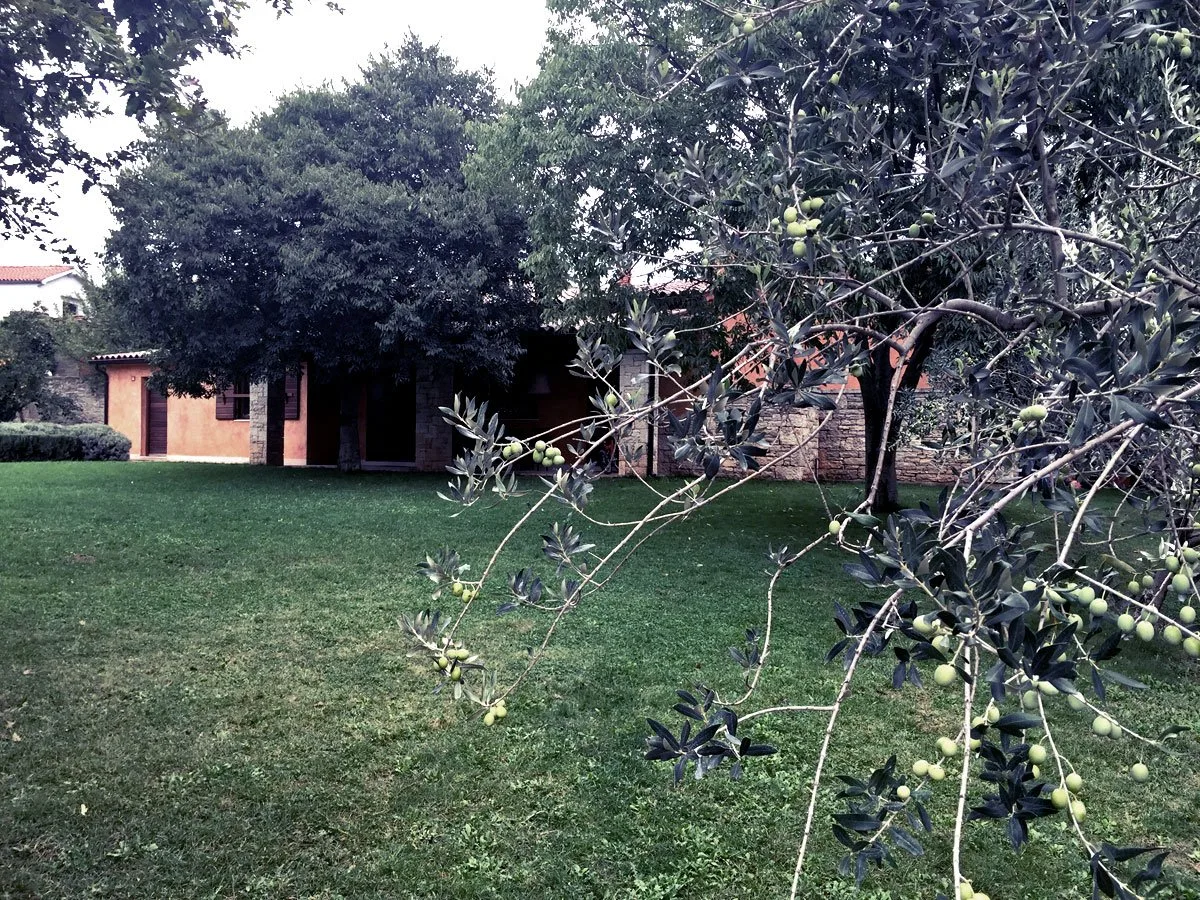
The tour was led by one of the two brothers who run the estate of 7,500 olive trees in Vodjnan. Tedi Chiavalon, who, together with his brother Sandi, have got to be two of the most energetic and charismatic olive oil producers, ever. They are part of the new breed of olive oil producers who have made a very conscious effort to turn their backs on more typical production practices in order to guarantee only the highest quality of extra virgin olive oil.
Tedi is passionate about this liquid gold, and you can feel it. During the olive oil tasting session, Tedi teaches guests everything about olive oil: how it’s made, how to smell it, how to taste it. Tedi has clearly made it his mission to arm guests with the knowledge of how to recognize good quality extra virgin olive oil — or, as Tedi refers to them, “honest” olive oil — versus the mass produced variety, over 80% of which he says are misleadingly labeled “extra virgin,” yikes!
Tedi Chiavalon on the left, with my husband Jeremy listening intently.
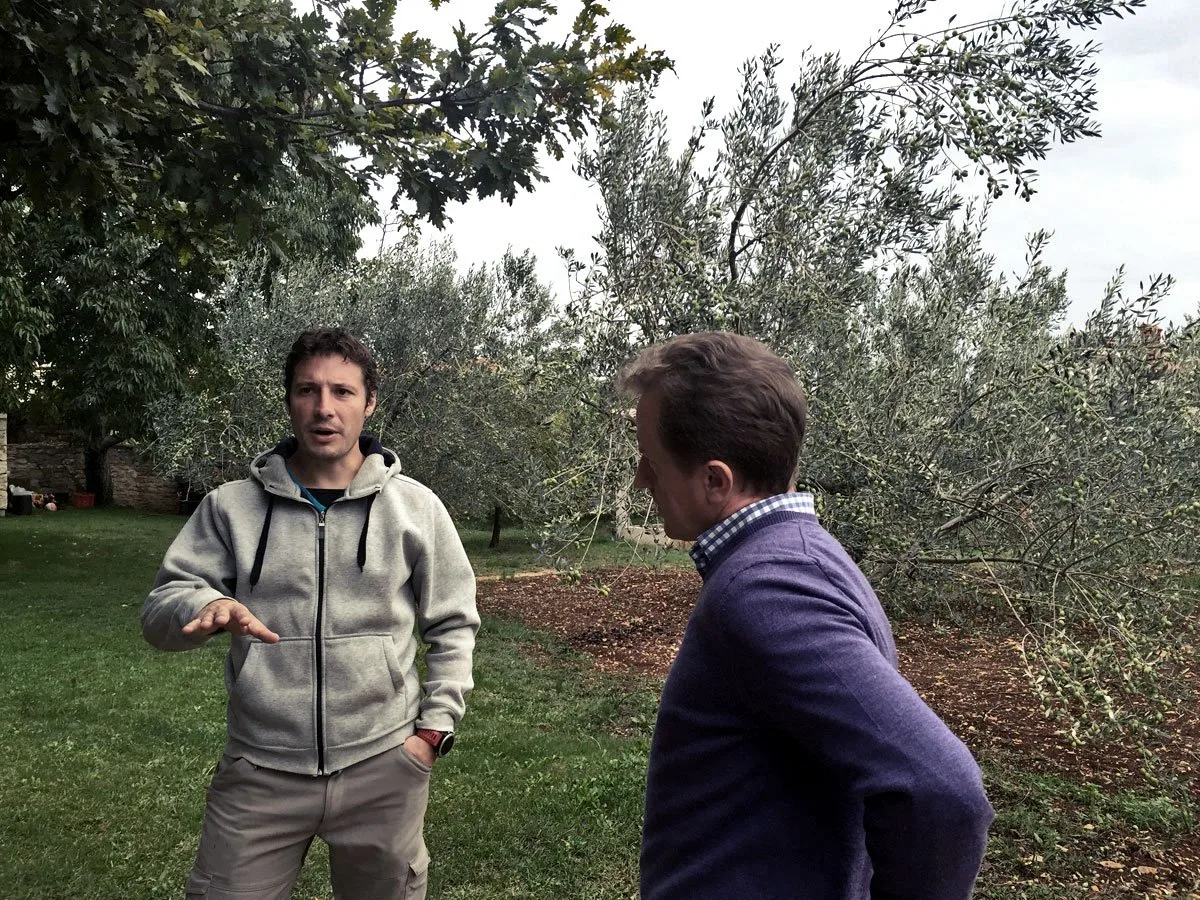
Below are 11 things that what we learned during our fascinating couple of hours with Tedi:
1. The Secret is in the Polyphenols
To understand the method to the Chiavalon brothers’ madness, you need first know that the secret to good olive oil is in the polyphenols, which are naturally-occurring micronutrients found in olive oil and other plant foods. “Honest” olive oil producers adhere strictly to methods that preserve polyphenols because more polyphenols means higher quality olive oil, superior both in taste and health benefits.
2. Harvest Early and Ye shall Yield Low Volumes, but Superior Quality
Chiavalon willingly sacrifices volume to get seriously delicious olive oil. They harvest their olives as early as October, or 2-3 months before the “meat” of the olives fully ripen from green to black. This is because green or young olives have higher amounts of polyphenols and have the stronger flavors associated with good quality extra virgin olive oil (more on this later).
However, because green olives contain much less oil, more olives are needed to yield a single bottle of olive oil and it is inevitably more expensive to produce. Tedi said that delaying the harvest by only month would give them as much as 5x more olive oil! But they resist the temptation to harvest in December or January as conventional producers do, because Chialvalon is not about the volume, it’s about taste.
With a conspiratorial grin, Tedi admitted that were his grandfather alive today, the Chiavalon patriarch would certainly deem him and Sandi to be mad!
3. Single-sort Olive Oils may be Trendy now, but they are not Necessarily Better
Chivalon may be the only olive oil producer in Istria that is not producing single-sort olive oils, which is olive oil made from a single type of olive (examples are leccino, picholino, or buza, which apparently are being marketed currently as the fashionable olive oils).
Sticking to a single type usually means having to coax a greater yield from the one type of olive (by harvesting later or at a higher temperature, for instance), which makes it harder to keep quality and excellence consistent. Chiavalon typically mixes and matches 4 or 5 sorts of olives and experiments with different tastes, like the artists that they are.
Chiavalon’s olive oil has consistently garnered ratings of 94 out of 100 in what is the official olive oil equivalent of The Parker Index for rating wine.
Tedi proudly shows off the multi-awarded Chiavalon Extra Virgin Olive Oil. Incidentally, the distinctive packaging — with its built-in paper bag that prevents oil from dripping from the mouth of the bottle to the table — has won several awards, too.
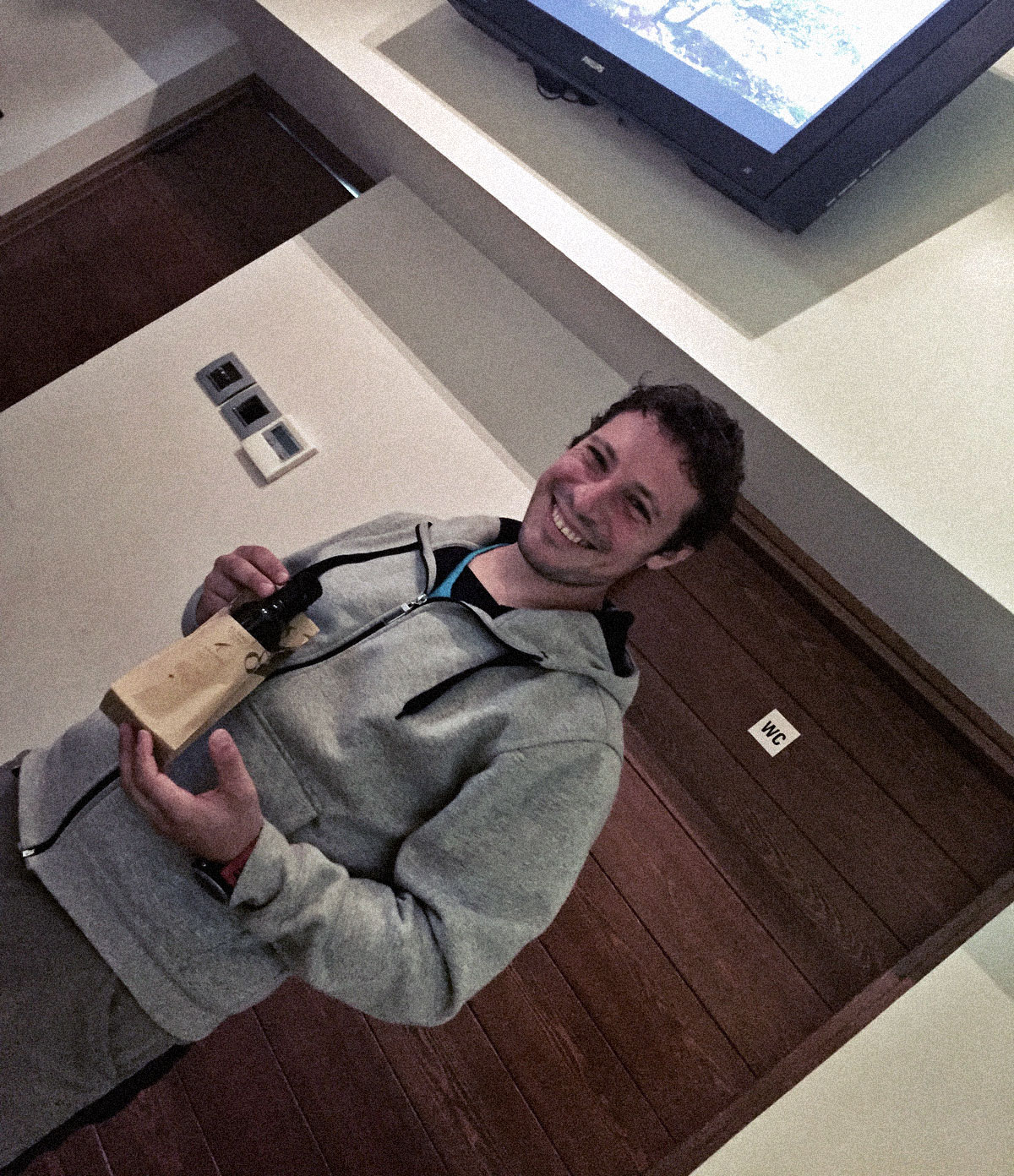
4. Make it Fast and Quick!
Harvesting is not the time to be slow and steady, and the reason is Enemy No. 1: Oxidation. Exposure to oxygen in the atmosphere destroys polyphenols. This is the reason why, during harvesting, Chiavalon rushes the olives to the mill 4 or 5 times throughout the day (which works out to about once every couple of hours), rather than just once at the end of the day like most everyone else.
This at first seems foolishly more labor-intensive than necessary, but what this achieves is to shorten the amount of time for each batch of olives to go from harvesting to pressing, thus limiting oxidation and preserving the all-important polyphenol component of the oils produced.
5. Bigger is not Better!
Oxidation is the same reason why olive oil should be purchased in small bottles. I am embarrassed to admit that this never occurred to me before, but it makes complete sense. Once the bottle is opened, the oxidation process begins, and the oil starts to lose its flavor.
So if you care about taste, keep walking when you see those gallon-sized tubs at the bulk stores. They may be cheaper in bulk, but as with all things, alas, you will get what you pay for (in terms of flavor). The largest bottle Chiavalon will sell is only 500 ml.
6. Do not Buy Olive Oil in Transparent Bottles
This was another revelation to me. Good olive oil is apparently sold in green or brown bottles because the colored bottles help to fight direct exposure to Enemy No. 2: UV rays. Tedi said many olive oils are sold in transparent jars to entice unwitting buyers with the oil’s color, but exposure to sunlight will cause polyphenols to degrade.
Olive oil in clear jars decorate the tasting room; the varying colors show how sunlight from the window affects the quality of the oil over time
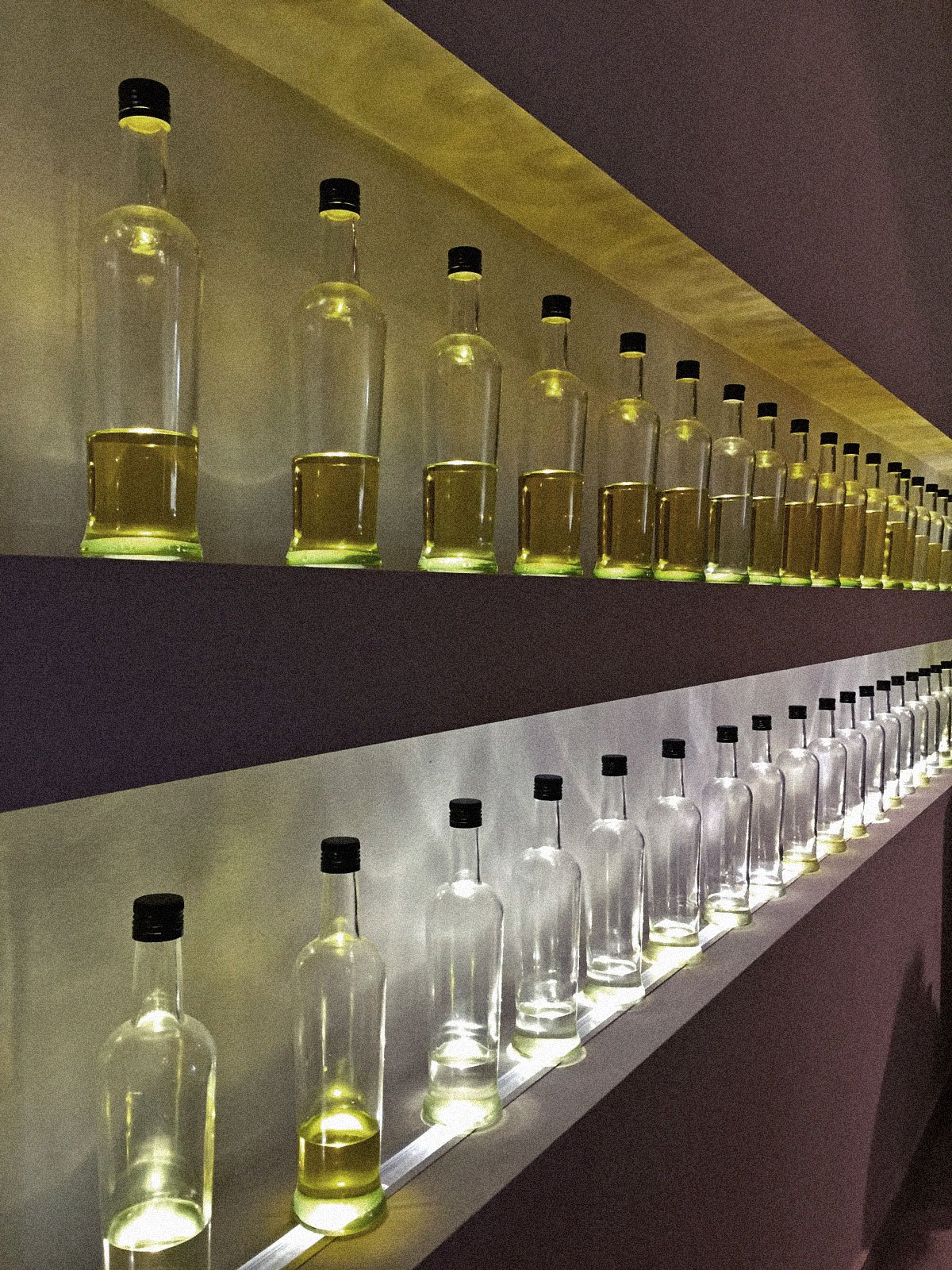
Interestingly, Tedi pointed to the transparent glass bottles on the shelves of Chiavalon Estate’s very modern tasting room as proof positive that olive oil should not be exposed to the sun.
The bottles containing olive oil displayed on the shelves are for purely decorative purposes, to create more interesting mood lighting. But over time, as sunlight from the window hits different bottles at different times and at different intensity, the once-uniform color of the oil in the bottles has become quite varied. UV ray degradation in plain view.
7. A Wine Fridge is the Perfect Place to Store Olive Oil
Tedi said that a good number of his guests make the mistake of keeping olive oil in the kitchen refrigerator, but most people know that keeping olive oil in the fridge is a definite no-no. The reason is that Enemy No. 3 is Temperature. It may shock you (as it did me) to learn that one hour in the fridge results in loss of quality equal to one entire year, oh my!
Olive oil can’t be too hot or too cold; it ideally should be stored at 12-24 degrees Celsius. I wondered aloud how to maintain this temperature range during very hot summers or during freezing winters. Tedi made a surprising suggestion, which is to store olive oil in a wine fridge if you have one. Fortunately for us, we have my husband Jeremy’s wine fridge at home, which he keeps at a temperature of around 14 degrees Celsius…and voila, problem solved.
Jeremy then asked whether the humidity in the wine fridge may be bad for the olive oil. But Tedi assured him that as long as the olive oil bottle is sealed properly, humidity will not be a problem.
Platter of ricotta and hard cow’s cheese
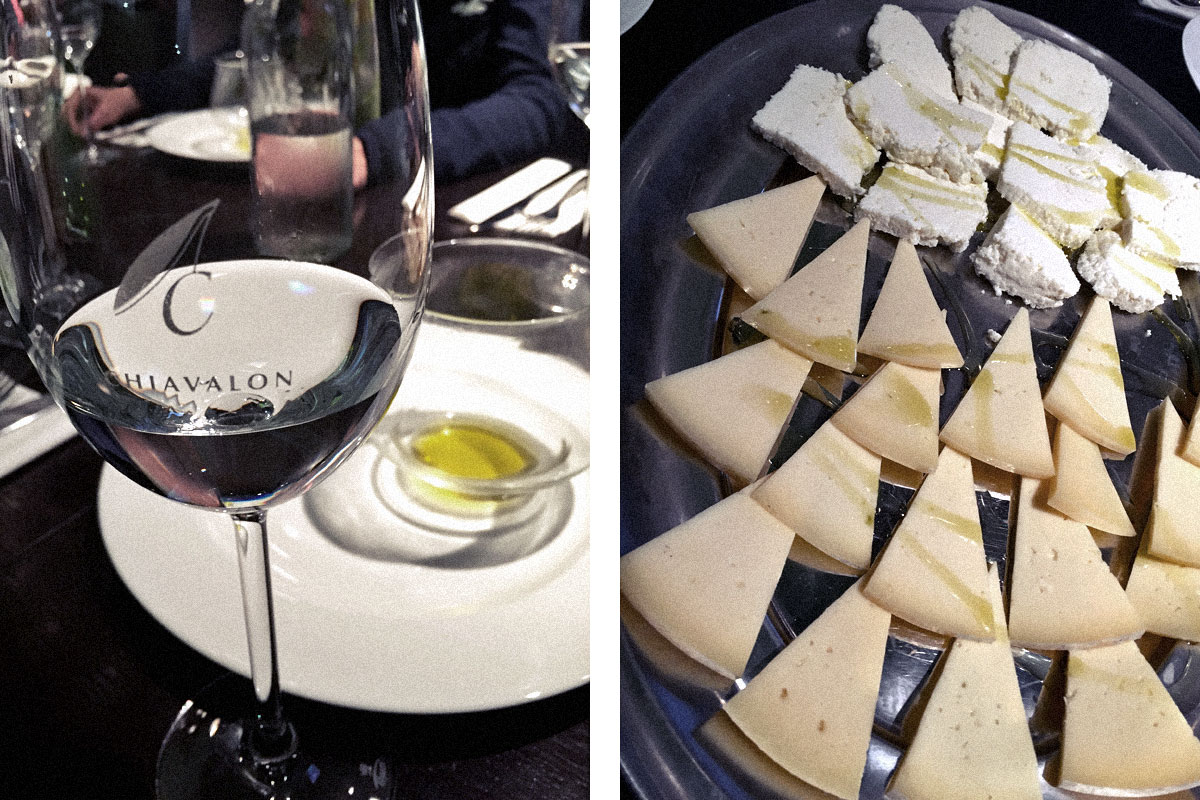
8. 80% of the World’s So-called “Extra Virgin” Olive Oil is Fake!
Temperature is also the reason why the best quality extra virgin oil is “cold-pressed” at no more than 21 degrees. Extra virgin oil may be pressed at up to 30 degrees, which will result in a whopping 50% more yield, but doing so will kill the structure, smell and taste of the olive oil.
Unfortunately, pressure from mass producers of olive oil have made international standards for labeling olive oil as “Extra Virgin” much more lenient, and many of the olive oils touted as Extra Virgin were actually pressed at higher than 21 degrees and are of inferior taste and quality to truly “cold-pressed” oils. Worse, many low-grade oils are blatantly mislabeled.
A 2010 study by the University of California Davis found that 69% of imported oils sampled failed to meet internationally accepted standards for extra virgin oil. Tedi reckons the real number is closer to 80%. (For those who are interested in learning more, Tedi promises that the book Extra Virginity will be a gripping read.)
9. How to Spot a Fake, Part One: Does it Pass the Smell Test?
Tedi asked us to take our first sniff of Chiavalon extra virgin olive oil then to describe the smell. When I told Tedi that it felt like smelling the color green, if green were an aroma, he beamed at me like a proud schoolteacher. I hit this one on the nose, ha!
Early harvested or green harvested olives will have the flavor notes of newly-cut grass. Some varieties may also taste fruity to some noses. It is a smell that is so strong and so distinct that it instantly evokes clichéd visions of green pastures in springtime. Trust me, when you smell good olive oil, you will know right away.
TIP: To coax the smells of the olive oil, Tedi poured a small amount of olive oil in a glass then asked us to cover the glass with one hand and rub the bottom of the glass with the other hand. He instructed us to apply friction continuously on the bottom of the glass until the olive oil gets to the ideal smell test temperature of 24 degrees. Then you stick your nose into the glass, just as you would with a glass of wine before tasting.
Jeremy demonstrates how to heat olive oil to the optimal temperature for smelling
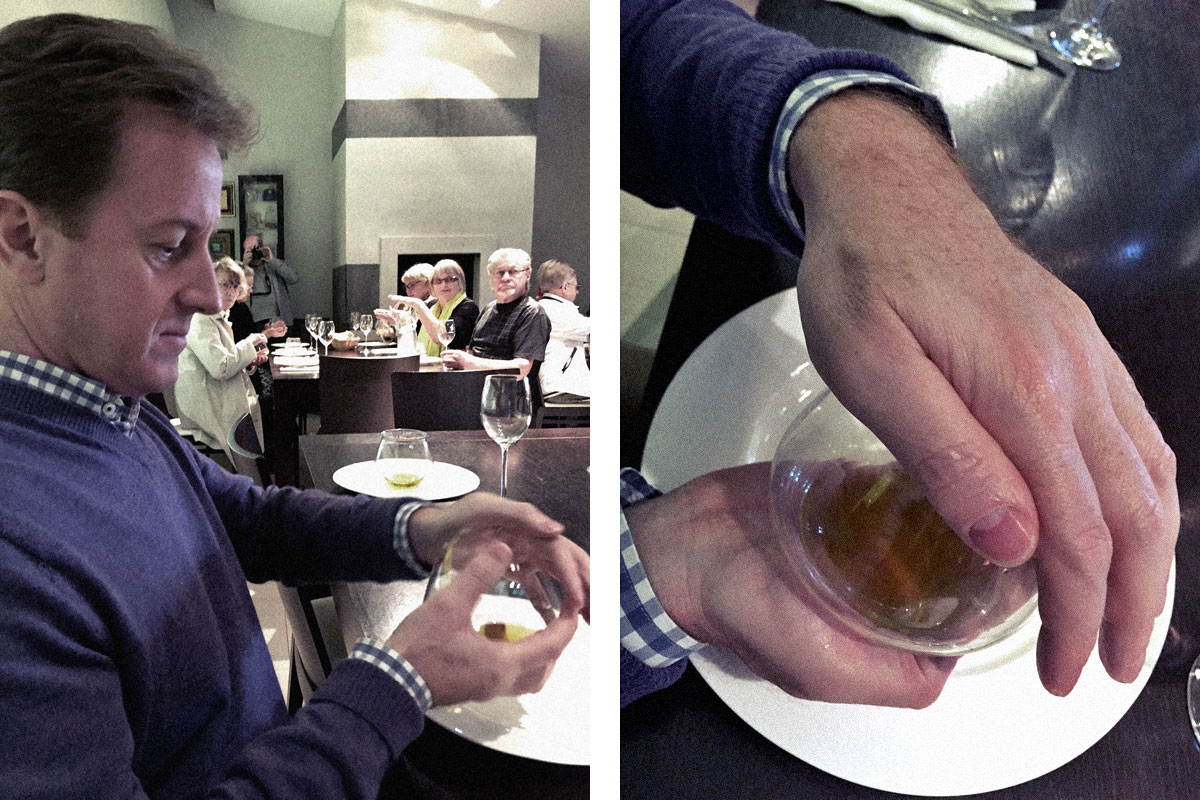
10. How to Spot a Fake, Part Two: Does it Make you Cough and Cry?
The most fascinating and hilarious part of the tour was the tasting itself. Olive oil is apparently correctly savored using a technique called stripping. Tedi did not explain how this very specific tasting method got its moniker, but stripping has nothing to do with shedding articles of clothing, nor is it even remotely sexy. I tried to get my husband to pose for a photo but he refused.
It goes like this: (1) sip a small amount of olive from a glass; then (2) flash a big smile with lips open and teeth clenched —think of a grinning Cheshire cat, or perhaps Jack Nicholson in The Shining — then (3) inhale very quickly to move the olive oil to the inside of your cheeks (if you make a sharp sucking sound when you do it, then you are doing it correctly — imagine an entire room of people doing this simultaneously, and you will understand why I say this part was hilarious).
If the oil is very good, it will taste bitter and spicy in your throat. Keep inhaling in short, quick bursts as needed, and you will feel more and more heat in your throat. Coughing and crying may ensue…but this is a good thing! If it doesn’t make you cry, don’t buy.
Tedi assured us that, armed with these two testing methods, anyone can spot an honest olive oil from a fake. To recap: green + bitter means polyphenols are in adbundance. And lots of polyphenols means the olive oil is honest.
11. Who Says you cannot Cook with Extra Virgin Olive Oil?
It is widely known that extra virgin olive is not ideal for cooking because of its low burning temperature. And not to mention because it can get damned expensive, especially if you use it for frying. But Tedi said this does not mean you have to limit the use of good extra virgin olive oil to salad dressings and dips alone. He shared with us some recipes for “cooking” with extra virgin olive oil, and even how to use it in a dessert!
To make a great steak, sear the steak on both sides in a pan. Depending on the thickness, cook just enough so that the inside is medium rare (naturally, as Tedi was quick to emphasize), then remove from the pan. Use a knife to make shallow criss-crossing cuts along the top of the steak. Rub in extra virgin olive oil, salt, and black pepper if you like on the serrated top, then cover the steak with foil to rest for a couple of minutes. Then enjoy.
You can also surprise and impress your guests with a very unique olive-oil sundae. Using a low drinking glass, put a layer of ricotta cheese at the bottom, followed by a scoop of vanilla ice cream. Drizzle olive oil on the top. You may also add a little strawberry sauce if you wish. (This would probably be best if the ice cream is the good kind, and the strawberry sauce is made from fresh strawberries.)
Final Thoughts
While I’m not sure I will have the chutzpah to actually try out the testing techniques imparted by Tedi the next time I am offered olive oil at a fancy restaurant (I cannot imagine ever uttering these words: “Waiter, this olive oil is no good. Please take it away!”), the olive oil tasting experience at Chiavalon was utterly illuminating and worthwhile.
I’ve been to a couple of other olive oil tastings in Tuscany, which involved nothing more than sampling 2-3 types of olive oils from plastic cups. But the Chiavalon brothers’ boundless enthusiasm and passion takes olive oil tasting to a whole other level.
The Chiavalon Estate experience is reason alone to visit Istria, in my opinion. I don’t know if it’s as readily available in other cities like Zagreb, so it’s certainly more than enough reason for me to come back for more Chiavalon liquid gold the very next chance I can get.
Chiavalon Olive Oil Estate, Croatia
Vladimira Nazora 16 52215 VODNJAN, Croatia
Tel: +385 52 511-906
Fax: +385 52 512-906
Mobile: +385 98 860-566
Website: chiavalon.hr
Email: [email protected]
Olive oil tasting is Euro 15 or 100 kuna per person, and includes snacks with the tasting. During our tour, we had a platter of hard cow’s cheese aged for one year, and ricotta cheese made the day before.
You can buy Chiavalon Extra Virgin Olive Oil at the end of the tour from their shop. The 250 ml bottle is 80 kuna, and the 100 ml bottle is 40 kuna. They also sell it in 500 ml bottles (but nothing bigger, of course!).
The exchange rate at the time of this writing was about 7.5 kuna for 1 Euro.
Photos by BJ Young

Nevia
Wednesday 14th of April 2021
They should named "Honest" olive oil. I strongly believe that Istrian oil is the best.
JB & Renée
Tuesday 20th of April 2021
Agreed Nevia! It really is the best.
Andrei
Wednesday 19th of July 2017
Amazing info, thank you. I am from Romania and travel kind of often to Greece, so I buy my olive oil from there, but never had a background on what to look for exactly. I knew that brown or green bottles are the ones to look for, but nothing else. So again, thank you!